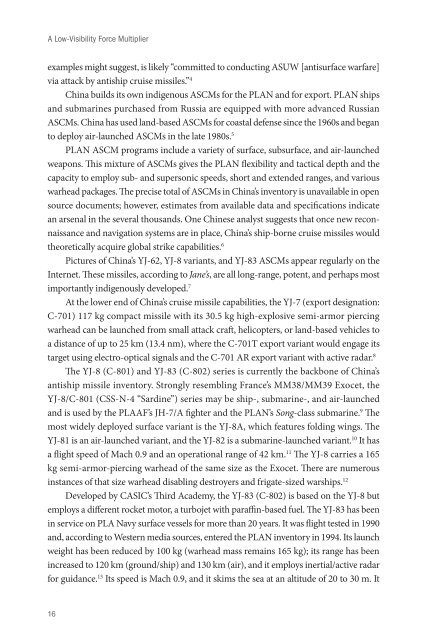Create successful ePaper yourself
Turn your PDF publications into a flip-book with our unique Google optimized e-Paper software.
A Low-Visibility Force Multiplier<br />
examples might suggest, is likely “committed to conducting ASUW [antisurface warfare]<br />
via attack by antiship cruise missiles.” 4<br />
China builds its own indigenous ASCMs for the PLAN and for export. PLAN ships<br />
and submarines purchased from Russia are equipped with more advanced Russian<br />
ASCMs. China has used land-based ASCMs for coastal defense since the 1960s and began<br />
to deploy air-launched ASCMs in the late 1980s. 5<br />
PLAN ASCM programs include a variety of surface, subsurface, and air-launched<br />
weapons. This mixture of ASCMs gives the PLAN flexibility and tactical depth and the<br />
capacity to employ sub- and supersonic speeds, short and extended ranges, and various<br />
warhead packages. The precise total of ASCMs in China’s inventory is unavailable in open<br />
source documents; however, estimates from available data and specifications indicate<br />
an arsenal in the several thousands. One Chinese analyst suggests that once new reconnaissance<br />
and navigation systems are in place, China’s ship-borne cruise missiles would<br />
theoretically acquire global strike capabilities. 6<br />
Pictures of China’s YJ-62, YJ-8 variants, and YJ-83 ASCMs appear regularly on the<br />
Internet. These missiles, according to Jane’s, are all long-range, potent, and perhaps most<br />
importantly indigenously developed. 7<br />
At the lower end of China’s cruise missile capabilities, the YJ-7 (export designation:<br />
C-701) 117 kg compact missile with its 30.5 kg high-explosive semi-armor piercing<br />
warhead can be launched from small attack craft, helicopters, or land-based vehicles to<br />
a distance of up to 25 km (13.4 nm), where the C-701T export variant would engage its<br />
target using electro-optical signals and the C-701 AR export variant with active radar. 8<br />
The YJ-8 (C-801) and YJ-83 (C-802) series is currently the backbone of China’s<br />
antiship missile inventory. Strongly resembling France’s MM38/MM39 Exocet, the<br />
YJ-8/C-801 (CSS-N-4 “Sardine”) series may be ship-, submarine-, and air-launched<br />
and is used by the PLAAF’s JH-7/A fighter and the PLAN’s Song-class submarine. 9 The<br />
most widely deployed surface variant is the YJ-8A, which features folding wings. The<br />
YJ-81 is an air-launched variant, and the YJ-82 is a submarine-launched variant. 10 It has<br />
a flight speed of Mach 0.9 and an operational range of 42 km. 11 The YJ-8 carries a 165<br />
kg semi-armor-piercing warhead of the same size as the Exocet. There are numerous<br />
instances of that size warhead disabling destroyers and frigate-sized warships. 12<br />
Developed by CASIC’s Third Academy, the YJ-83 (C-802) is based on the YJ-8 but<br />
employs a different rocket motor, a turbojet with paraffin-based fuel. The YJ-83 has been<br />
in service on PLA Navy surface vessels for more than 20 years. It was flight tested in 1990<br />
and, according to Western media sources, entered the PLAN inventory in 1994. Its launch<br />
weight has been reduced by 100 kg (warhead mass remains 165 kg); its range has been<br />
increased to 120 km (ground/ship) and 130 km (air), and it employs inertial/active radar<br />
for guidance. 13 Its speed is Mach 0.9, and it skims the sea at an altitude of 20 to 30 m. It<br />
16


